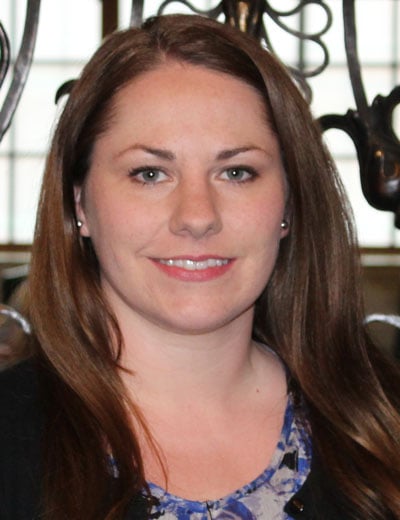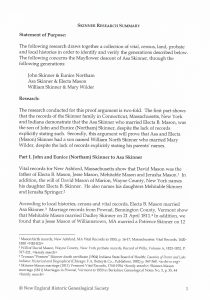As part of the NEHGS Research Services team, I spend a lot of my time documenting lineage society applications. We often receive requests to document lines that require some additional attention. For instance, there can be some generations that simply cannot be connected through birth, marriage, and death records. Perhaps there are no vital records for the time period and location, or you may have vital records that do not include critical information such as parents' names. When these genealogical obstacles occur, a proof summary may be needed to demonstrate the connections between the generations.
A proof summary, also called a proof argument, is simply an essay which summarizes all sources you have gathered to link the generations. It is compiled in a way to be persuasive enough to connect generations, despite the lack of vital records or direct evidence for the generational connection. These proof summaries are a surprisingly common addition to lineage society applications.
If you do not have at least one vital record naming the parents of the line carrier, a proof summary may be needed. However, if you can find a will where the child is named or land records that specifically name children, a proof is not always necessary. Make sure to exhaust all possible sources for the location and time period before you begin.
Proof summaries vary greatly in the amount of additional research that may be needed and take on many different forms. Here are just a few examples of some items commonly included:
- Vital records do not name parents. Sometimes a proof can be a very simple one paragraph statement. For example, Sarah (your line carrier) and Samuel are on a census together with their parents. You have a death record for Samuel that names the parents. You can use the census record to link Sarah and Samuel. Finding vital records for the siblings can be an easy way to show parents by association. You can also link siblings through land or probate records.
- Migration patterns. Sometimes you may not be able to link siblings so obviously through census or probate. For example, say your line carrier is John Smith Jr. You do not have sources to prove his relationship to his father John Smith Sr. However, you do have evidence to show that Michael Smith, brother of John Smith Jr., was the son of John Smith Sr. If you can show that both ended up migrating to the same location and that they interacted with one another, this is evidence that can be included. Look for evidence of interaction through land, probate, and church records.
- Changes in location. Sometimes changes in location may complicate your lineage society application. For example, how do you know that the John Smith Jr. who was born in New York in 1810 was the same John Smith who died in Ohio in 1880? Look for sources that show his age and birth location. Cemetery and census records are useful for calculating an age or establishing a birth date. If you can show that the John Smith of Ohio was born in New York in 1810, that is a great piece of evidence. In addition, look at land records for previous locations. You may find that Ohio land records say that John Smith was “of New York” when he first bought land in Ohio, thus showing his connection back to that location.
- Women as line carriers. Say you have to show that Mary Parker, wife of Thomas Parker, was actually Mary Jones, daughter of Peter Jones, your line carrier. Quit-claim deeds are a great piece of evidence to show connections. For instance, you might find Thomas and Mary Parker quit claiming their rights to some land with other individuals. Do some investigating to find out who those people are. They may be other children of Peter Jones. In addition, gather vital records for all the children of Thomas and Mary Parker. If you can find records that show her maiden name was Jones, you can include this in your argument.
Here are some other tips that may help:
- Find a good family genealogy. While no lineage society will accept a genealogy as proof by itself, they are often great sources to use to bring your argument together. Make sure to verify the facts presented within. Does it contain a lot of errors? You may not want to use it. A genealogy with errors brings the validity of the entire book into question. You cannot confidently say that one fact in it is wrong, while another is right.
- Consider naming patterns. If you have a unique name or names that are passed down through the generations, you can include this in your proof summary.
- Be concise. A lineage society does not need unnecessary information. Include only the sources to demonstrate the connection. Keep it short: one to three pages is the norm. However, it can be longer depending on the complexity of your argument and the number of sources you have.
- Organize your thoughts. This may be obvious, but you should have an introduction, body, and conclusion. Don’t be afraid to spend some time organizing your argument so that it flows nicely. If you have three generations to link, do so in one essay. I like to denote sections for each such as Parts I and II for the sake of clarity.
- Use persuasive language. Use phrases such as, “these sources clearly show.” Don’t allow room for doubt.
- Not all lineage societies have the same qualifications. For example, the Mayflower Society will in certain cases accept genealogies and local histories, whereas the Daughters of the American Revolution will not. The same goes for naming patterns. Examine the particular qualifications for the society you are applying to before deciding the sources you will use in your proof summary.
- Not sure you have enough evidence? Put your thoughts down on paper. You will often find you have more evidence than you think once you see it all come together.
- Find another line. Unfortunately, despite best efforts a proof summary may not convince the person reviewing the application. If this is the case, try finding another line to pursue that might be easier to document, such as one that includes Massachusetts families rather than families in New York.
Of course, NEHGS Research Services has a team of lineage specialists who can help you with your application. You can contact the Research Services Coordinator for more information. Good Luck!
Share this:

About Michelle Norris
Michelle holds a master’s degree in history from Salem State University, where she specialized in women in colonial New England. She completed her bachelor’s degree with concentrations in history and gender studies from the University of Massachusetts, Lowell. Michelle has a background in public history and has worked with the National Archives and Records Administration in Waltham, the Beverly Historical Society, and the Sargent House in Gloucester, Massachusetts. Her research interests include women’s history, society and culture, early America, and the American Revolution.View all posts by Michelle Norris →
